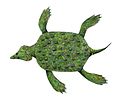Ophthalmothule (meaning "eye of the north"), was a cryptoclidid plesiosaur dating to the latest Volgian (around the Jurassic-Cretaceous boundary), found in the Slottsmøya Member Lagerstätte of the Agardhfjellet Formation in Spitsbergen. The type species is O. cryostea.[1]
Description


Ophthalmothule was a medium-sized plesiosaur, measuring 5–5.5 metres (16–18 ft) long. It was noted to have unusually large eye sockets, which suggests a paleobiological specialization, such as deep water and/or nocturnal hunting. Along with Abyssosaurus, it is one of the youngest cryptoclidids known from boreal regions. The holotype is known from skeletal material that includes a complete cranium and a partial mandible, a complete and articulated cervical vertebrae, a set of pectoral and anterior to middle dorsal series, and the pectoral girdle and anterior humeri.[1]
References
- ^ a b Roberts, A.J.; Druckenmiller, P.S.; Cordonnier, B.; Delsett, L.L.; Hurum, J.H. (2020). "A new plesiosaurian from the Jurassic–Cretaceous transitional interval of the Slottsmøya Member (Volgian), with insights into the cranial anatomy of cryptoclidids using computed tomography". PeerJ. 8: e8652. doi:10.7717/peerj.8652. PMC 7120097. PMID 32266112.





















You must be logged in to post a comment.